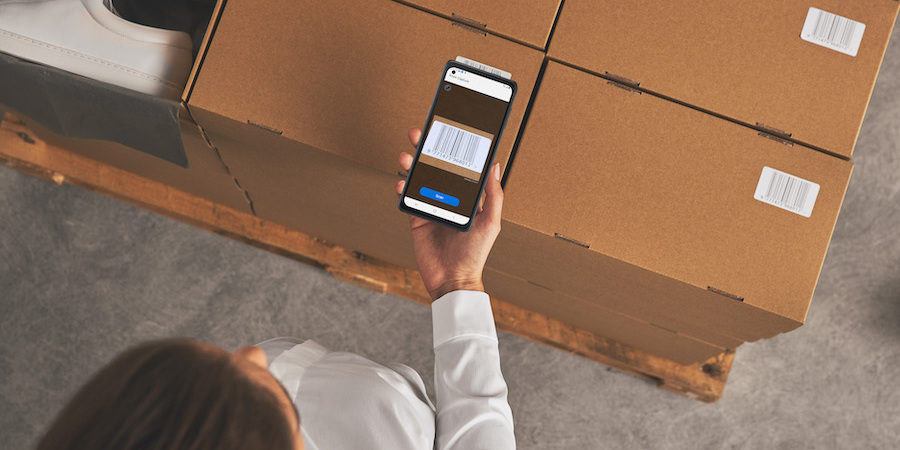Samsung is responding to the needs of large businesses by adding enterprise-grade barcode scanning capabilities to its rugged mobile devices with the introduction of Knox Capture, a no-code solution that can scale to thousands of devices.
Based on a partnership with Zurich-based Scandit, Knox Capture allows businesses to use the high-resolution built-in cameras on Samsung devices, such as the rugged Galaxy XCover Pro, to instantly access scanning capabilities within an Android or web app. With no integration required, a user-friendly interface and an advanced data capture engine, Knox Capture gives businesses the opportunity to retire legacy scanning devices and embrace the mobile future.
“Many of our enterprise customers still maintain a large fleet of dedicated scanning devices, when the reality is their smartphones and tablets can deliver the capabilities they need,” explains Bala Thinagarajan, who heads up enterprise software product management at Samsung Electronics America. “With Knox Capture, we brought together the powerful scanning engine from Scandit and Knox’s productivity capabilities to create a turnkey solution for enterprise scanning on our rugged devices.”
With Knox Capture, barcode scanning can be launched with the squeeze of the XCover Pro’s physical buttons, ideal for workers wearing gloves. Alternatively, the scanning capabilities can be accessed by tapping the scanning icon within the on-screen keyboard, making it convenient to capture data when completing forms.
When setting up Knox Capture, businesses can optimize functionality for their typical use case by adjusting the scanning logic with settings like barcode type, camera zoom and scanning mode. Scanned data can also be customized for output by adding prefixes, suffixes and tab or return keystrokes.
Barcode scanning has become mission-critical
According to Valentine Igbokwe, Samsung’s product manager leading the rollout for the new solution, Knox Capture was developed based on the recognition that integrated barcode scanning has become one of the most important factors in choosing a rugged mobile device.
“Think about courier services that need to capture proof-of-delivery when they drop off a package, for example, or an on-demand food service bringing a meal kit to someone’s door,” he says. “Beyond those ‘last mile’ scenarios, there are all the use cases associated with field service operations and inventory management in sectors such as retail and manufacturing.”
Mobile device management for beginners
Get started with MDM so your organization can spend less and do more — securely and efficiently. Download Now
The challenge, until now, was that adding barcode scanning to mobile devices has traditionally meant a lot of work for IT departments. The process might involve working with third-party software development kits (SDKs), for example, figuring out which application programming interfaces (APIs) they would need to integrate and configure.
Even after all that, IT would often still have to worry about whether mobile-based scanning would be limited in range or performance, or would support the kinds of barcodes they needed to capture.
The Knox Capture advantage
In contrast, Igbokwe says Knox Capture requires no software development because Samsung has already done the work to integrate Scandit’s capabilities to create a native user experience on the XCover Pro. Knox Capture is also optimized to get the greatest scanning performance out of the cameras on Samsung rugged devices.
Igbokwe says the availability of scanning capabilities on every employee’s mobile device opens up considerable opportunities to enhance customer experiences and streamline workflows.
“Consider a nationwide retailer that uses dedicated scanning devices to conduct price checks or answer questions. Those devices are often expensive, and you can’t deploy them to everybody,” he says. “Because of that, you might only deploy one to someone at a manager level who oversees a certain section of the store floor. But with Knox Capture, that retailer is able to give those scanning capabilities to all associates on a rugged mobile device — a device that they can also use to communicate with colleagues, for timekeeping and attendance, and so much more. This will change how the business thinks about the total cost of ownership (TCO) for scanning capabilities.”
Extending the power of Knox Capture
With Knox Capture, there’s no dedicated scanning hardware to manage and maintain. Scanning capabilities are deployed remotely via the enterprise’s mobile device management (MDM) or enterprise mobility management (EMM) console. After purchasing Knox Capture licenses, they can be quickly activated and assigned to devices over-the-air, together with barcode scanning configurations. Device configurations can also be shared rapidly device-to-device, via NFC or QR code.
Customizations can also be made rapidly. For example, a business could pivot quickly to scan a different type of barcode if needed — as part of a holiday promotion, for instance — simply by changing a policy inside Knox Capture and deploying it using their MDM/EMM.
Knox Capture is launching at a time when almost every industry is exploring ways to bring simple, zero-touch digital interactions to a wide variety of everyday tasks and processes. Igbokwe predicts both IT and business users are just beginning to come up with creative applications where scanning will prove essential.
“A lot of the larger Fortune 500 companies are thinking about their overall strategy from an end-to-end digital transformation perspective,” he says. “They’re wondering how they can change the game. Knox Capture is going to mean digital transformation gets very interesting, very quickly when it comes to enterprise scanning.”
Learn more about Samsung’s Knox Capture scanning solution — and sign up for a free trial to see it in action.









